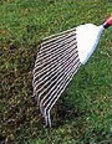Scarification
Scarification removes thatch. The most basic (but very effective) form of scarification is carried out by using a springbok rake. Other forms of scarification include electric scarifiers and motor scarifiers (including self propelled). These can be purchased or hired from local hire centres.

The benefits of scarification are:
* Removes thatch
* Heavy scarification will make spongy/soft lawns firmer
* Makes an ideal seed bed for overseeding
What is thatch?
Thatch is a layer of dead fibrous material. It is made up of clippings not collected and dead roots. Certain grasses such as fescue are known to produce more thatch (ie fine lawns need regular scarification).
Thatch less than 12-15mm is useful and acceptable as it adds springiness and cuts down surface water loss.
Thatch over 25mm thick is harmful. Water penetration is reduced, especially if the thatch is allowed to dry out causing problems such as dry patch. Root development is restricted by the thatch.
Thatch will lock up nutrients making them unavailable to the grass.
How to remove thatch:
Firstly, cut the lawn at your normal height of cut.
Scarify, by using a rake or mechanical machine in 2-3 directions. Clear debris after each direction. Then, if you dare, scarify again in another direction.
REMEMBER:
You will never kill your lawn by too much scarification! The more the better!!
Lightly overseed the lawn using a quality fertilizer.
Apply an autumn or pre-seed fertilizer.